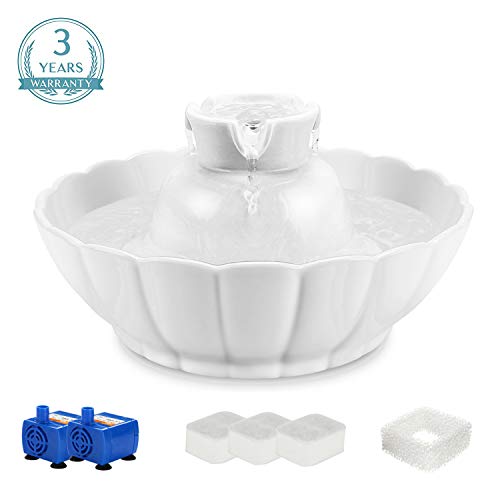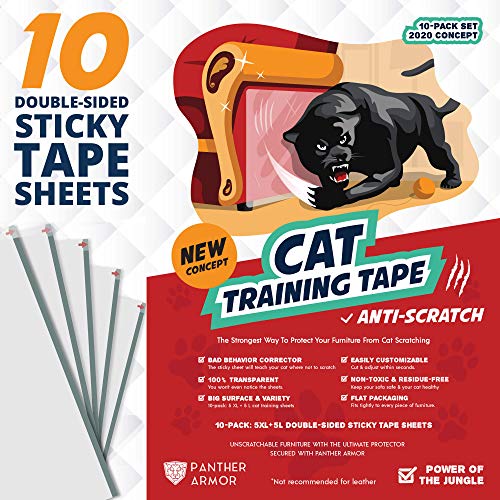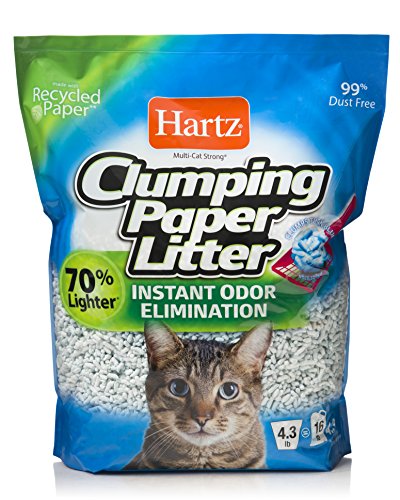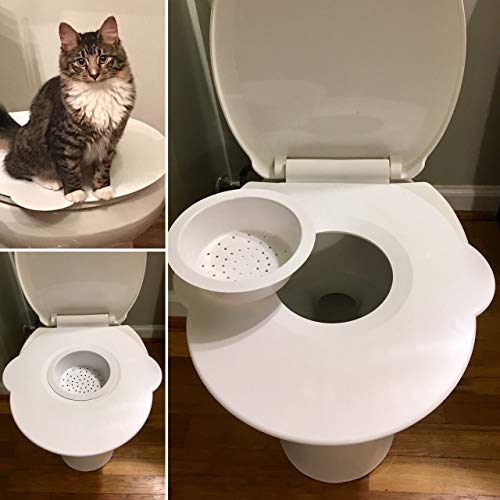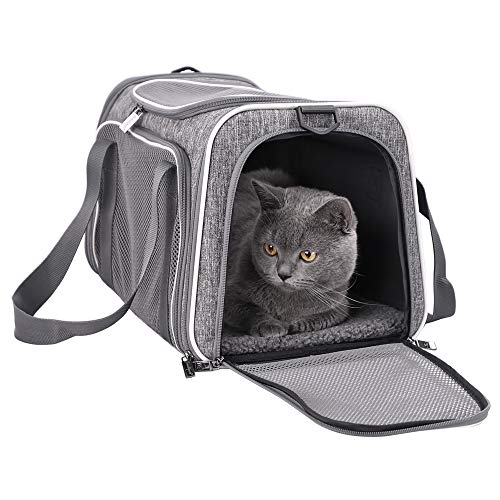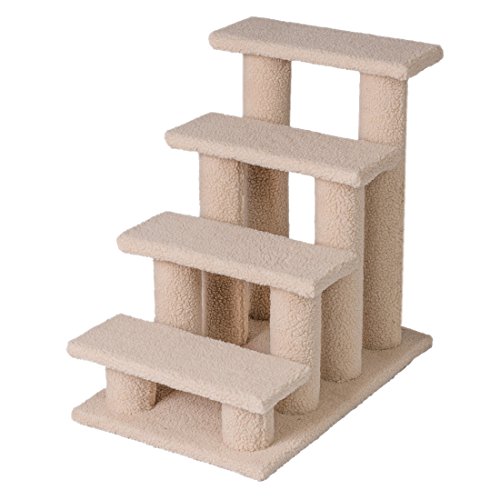Congratulations on your new family member! Kittens can bring us so much joy and love, but bringing a new kitten home can also be a little nerve wracking. Is the house “kitten proof”, do you have all the supplies you need? What to feed? What if they get an upset tummy from all the changes? What about the litter box?
Here’s a helpful list of things I recommend for my clients with new kittens (or even new adult cats!) to make sure your new kitten is on the right track for holistic care to maximize their health and well-being.
For more information on my general recommendations for medical stuff like vaccines, deworming, how much to feed, and what kind of issues to watch out for see my downloadable Kitten FAQs.
This post contains affiliate links which I may earn commissions from. As an Amazon associate I earn from qualifying purchases.
Food and Water Bowls
I like ceramic, glass, or metal food and water dishes. Remember that cats are originally desert creatures who hunted and got most water from their food. They really don’t have a good instinct to drink water from a bowl. You should still always have a water bowl available but also have a source of moving water such as a fountain available too.
Eating out of a bowl doesn’t really come naturally to cats either. Steep sided bowls end up hitting their whiskers which are very sensitive. Stick with shallow bowls or plates.
Or even better, feed your kitten using a slow, interactive, or puzzle feeder. This lets them use those natural hunting instincts and helps them get their energy out in a healthy way.
Collars & Harnesses
Collars should be fit so they can’t be pulled off over the ears but can be moved up, down and around the neck easily. Since kittens grow so quickly you’ll probably have to loosen the collar weekly which means you may have to get a larger collar before they’re fully grown. Flat collars are the safest for wearing all the time and there are collars designed to break with enough pressure in case your cat ever gets the collar stuck on something.
Cats can learn to wear a harness and leash to go exploring safely outside. Make sure it fits snugly and doesn’t inhibit the movement of the front legs. Walking a cat isn’t like walking a dog; let your cat sniff and explore at their pace.
Toys
There’s going to be a lot of playing and chewing so you’ll need a variety of toys. Different cats like different types of toys so try out some different kinds. Avoid laser pointers since they can be frustrating since cats can’t ever catch them.
Interactive toys are great since they can keep your kitten entertained for a while so they don’t Zoom-bomb that important meeting.
Of course you need some catnip toys too! Some cats don’t care about it and some cats get too excited but most cats love it.
Any toys with parts that could be chewed off and swallowed like string, rope, feather or plush toys are fine with supervision but not safe unsupervised. All toys should be big enough that your kitten can’t swallow them.
Scratchers
Scratching is a normal behavior for cats. By giving them appropriate and desirable scratching areas we can reduce the risk of them scratching things we don’t want. Different cats like different surfaces and textures for scratching so get a variety.
The product Feliscratch is a pheromone that can be applied to areas you want to encourage them to scratch. You can also try plastic or sticky tape to discourage scratching in some areas but some cats actually like scratching these surfaces!
Litter Boxes and Litter
Super important to make sure your kitten starts off on the right foot with litter box training! There are many different styles of boxes and litters so it’s important to try out a few to see what your cat prefers. It’s a good idea to start off with a simple low sided box for easy access as your kitten learns. If the litter box has high sides place a few books or a small box in front as a step so it’s easy for your kitten to get into until they’re bigger.
Once they’ve got the hang of using the litter box you can try out some other styles too to see what they prefer. Avoid the “top entry” type though most cats don’t like this style and it adds more strain to their joints requiring them to jump in and out every time. Remember to have at least 1 more litter box than you have cats and to have at least one box on every floor to help avoid accidents.
There are many options for litter: paper, clay, wheat, corn, clumping, non-clumping etc. The best litter is the one your cat likes best and will use! Try out several kinds to see what your kitten prefers just look for low dust and avoid all dyes and fragrances (natural or artificial) as cats are extra sensitive to these.
If your cat needs some extra encouragement to use the litter box you can try Cat Attract litter or litter additives (basically catnip).
Litter Box Management
Keeping the litter box clean is important for your cat and you! Trays and puppy pads can help with litter tracking or in case of any near misses when learning. Scoops are a necessity. There’s also liners and litter cans that can make the process easier.
Want to make it even easier? There are many systems to make cleaning easier from sifting litter pans to fully automated self cleaning systems.
Toilet training
Cats can be trained to use the toilet. However they should always have a litter box available as a “back up” in case they don’t have access to the toilet.
Beds, trees and perches
Cats feel safest when they are up high. Also looking out the window is “kitty tv”! Try out cat trees and perches of different heights and try to place them so they can use them to see out the windows.
There are also window perches you can try.
Some cats like to have very enclosed beds or spaces to hide in.
Some cats like a flat soft bed on their favorite spot on the couch or bed, some like a puffy bed on the floor or couch.
Food
Having real, minimally processed, bioavailable, food is even more important for growing kittens than for adult cats! I like dehydrated or freeze dried foods, commercial fresh or cooked foods, or a complete and balanced homemade diet. Kittens do have special nutrient requirements but guess what, most foods are actually kitten food! If the package says somewhere on it that it meets or was formulated to meet AAFCO requirements for All Life Stages it’s kitten food.
Here are a couple freeze dried options but I don’t actually recommend any specific brands due to lack of transparency in the industry. I also recommend rotating brands and protein sources to help avoid any potential issues with any given brand or protein.
Check out my other blog posts on why to avoid dry food and my Kitten FAQs guide for more information and to learn how much to feed and how to monitor weight so your kitten stays lean and healthy!
Treats
As always the less processed the better. Things like freeze dried liver, lung, or meat as well as bonito flakes and freeze dried shrimp are great treats and can be chopped finely or broken into small pieces to make very low calorie, high value rewards. Of course catnip is great to put in treat balls or on cat trees for entertainment.
Keep them all over the house or even try a wearable treat bag so you can always reward those good behaviors! Put them in a treat ball to combine snack time and play time.
Automatic Feeders
Sometimes you can’t be there to feed your kitten. Try one of these automated feeders which will work for real food instead of kibble/dry food!
Catios
Staying indoors is much safer for cats and protects birds and other wildlife but indoor only life can be less exciting for cats and lead them to develop some bad habits. The perfect compromise is a Catio! These enclosures allow your cat to safely enjoy all the sights, sounds, and smells outside. Available in all shapes and sizes premade or DIY and can be set up against the house so your cat can go in and out by a cat door whenever they want.
No outdoor space available? Check out these tips to keep your cat entertained inside.
Carriers
All kittens should learn to be comfortable getting in their carrier so they can travel to the vet and with you on trips and moves with minimal stress. Look for a carrier that can be opened from the top so your cat never has to be pulled out through the front.
Other
Leaving their mom, litter mates and home is stressful and scary but calming pheromones in Feliway can help make the transition easier for your new kitten.
Stairs and ramps are critical for kittens to learn to use now. By the age of 6 half of cats already have arthritis which only worsens with age, so it’s good for them to learn to use these things now so they can use them to help their joints as they age and develop arthritis.
Kitten Proofing
The best way to avoid trouble with chewing or eating something they should is to just prevent your new kitten from having access to things that could cause trouble. Never leave any sort of string, shoe laces, yarn, hair ties, or rubber bands where your kitten could access them unsupervised. These are commonly swallowed and can cause an emergency situation blocking the intestines. Keep shoes with laces in cupboards or otherwise out of kitten reach. Put all hair ties and rubber bands in drawers. Lilies are very toxic to cats, don't bring them in a home with cats. Tylenol (acetaminophen) and other human medications are also very toxic to cats so keep them in a cupboard and make sure you pick up any dropped pills. Chewing on electrical cords can cause burns, try cord protectors to prevent this.
Grooming and Oral hygiene
All cats should get used to having their feet handled and their nails trimmed. Small pet nail clippers or human nail clippers will work. Never clip nails without knowing where the styptic powder is just in case a nail is cut too short.
All kittens should learn to allow their mouth to be looked at and their teeth brushed. Usea small head toothbrush with “cat toothpaste”.
All cats and especially those with long hair should also get used to regular brushing. Some cats like a grooming glove since then they’re getting pets and grooming.
Cats should groom themselves and never need a bath unless they have certain medical conditions or have gotten something toxic like car oil or lily pollen on them in which case veterinary care is appropriate. If they need some “spot cleaning” use water or a fragrance and dye free wipe or baby dry shampoo.
Training
Cats are actually very trainable! Whether you want teach tricks or just want to teach them to tolerate nail trims, positive reinforcement is the way to go. Reward the behaviors you want and ignore the ones you don’t. Decoding your cat is written by veterinary behavior specialists and answer many common questions. Another great training tool is clicker training. Check out this fun book on clicker training cats. Don’t forget treats, treat jars and pouches from above so you can always have treats ready to reward good behaviors.
First Aid & Emergencies
Kittens are more vulnerable to illness than adult cats so you should always consult with your vet for any issues.
Always consult your vet before using any of these products for your pet. Diagel is a natural product for mild diarrhea, Optixcare Eye Health is a natural product for eye irritation, and Zymox is a natural ear cleaner.
It’s a good idea to look up the nearest emergency vet and put their number in your phone now and also put the ASPCA Pet Poison Hotline number 800-213-6680 in your phone in case your cat eats anything they shouldn’t.
Want to learn more about getting your kitten off to a holistic start? Check out my Kitten FAQs guide!



